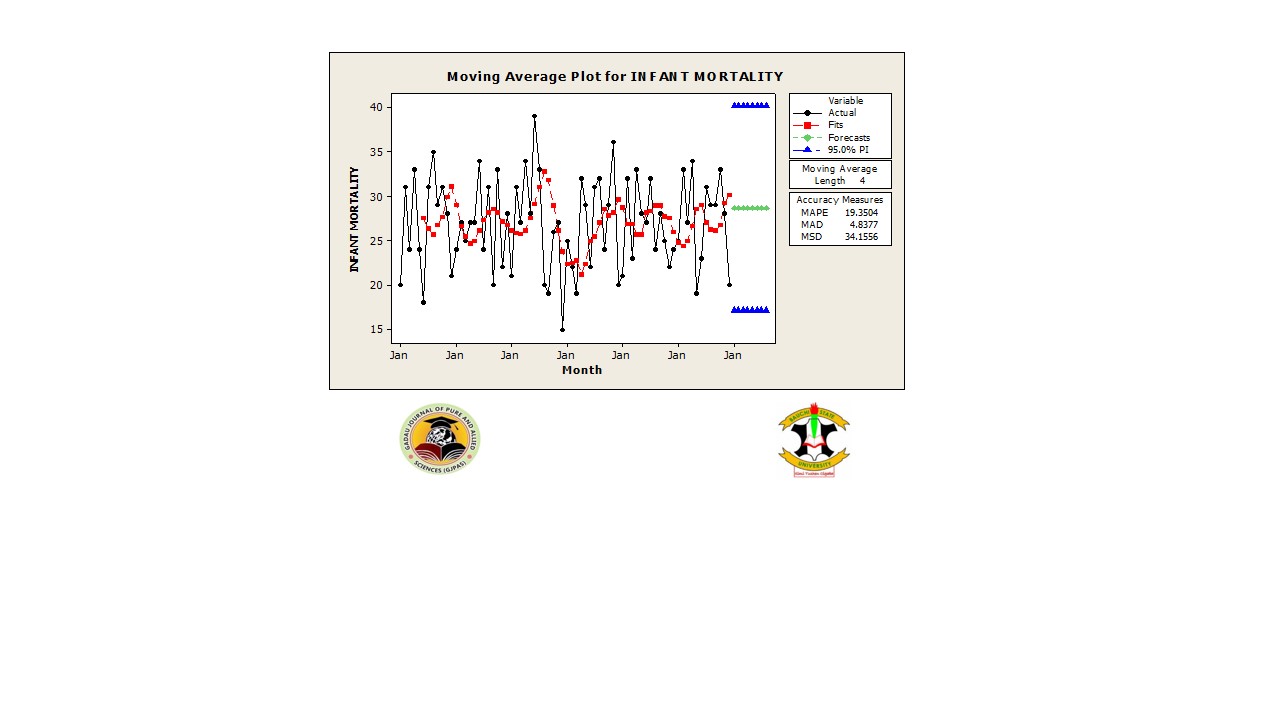Forecasting Infant Mortality Rate using Exponential Smoothing and Moving Averages Techniques
DOI:
https://doi.org/10.54117/gjpas.v2i1.15Keywords:
Infant,, Mortality, Time Series, Damaturu, YobeAbstract
Infant Mortality Rates (IMR) are important indicators of health status of any country. This research presents Time Series Analysis using Exponential Smoothing and Moving Averages (MA). Six years data on infant mortality covering 2016 to 2021 was obtained from Yobe State Specialist Hospital Damaturu. We used Single Exponential Smoothing, which at =2, the model showed a smoothed trend of infant mortality over the period of 72 months. A forecast made based on this smoothed trend indicated a constant rate of infant mortality over the period of 8 months with MAPE = 17.9165, MAD = 4.5133 and MSD = 30.2982. We also studied nature of trend using Moving Averages (MA) and forecast made at length = 4 showed a constant rate of forecast over the period of 8 months with MAPE = 19.3504, MAD = 4.8377, and MSD = 34.1556. Based on the three accuracy measures, single exponential smoothing method presented a better fit to the data. Highest infant mortality was observed in 2021 with total death of 331 which represents 17.08% of the total deaths.
References
Adepoju, A. O., Akanni, O., and Falusi, A. O. (2012). Determinants of child mortality in rural Nigeria. World Rural Observations, 4(2), 38-45.
Adewusi, A. O., and Nwokocha, E. E. (2018). Maternal education and child mortality in Nigeria. The Nigerian Journal of Sociology and Anthropology Vol, 16(1), 112.
Akinyemi, J. O., Bamgboye, E. A., and Ayeni, O. (2015). Trends in neonatal mortality in Nigeria and effects of bio-demographic and maternal characteristics. BMC pediatrics, 15(1), 1-12.
Anggrainingsih, R., Aprianto, G. R., and Sihwi, S. W. (2015). Time series forecasting using exponential smoothing to predict the number of website visitor of Sebelas Maret University. In 2015 2nd international conference on information technology, computer, and electrical engineering (ICITACEE) (pp. 14-19). IEEE.
Appiah, S. T., Otoo, H., and Nabubie, I. B. (2015). Times series analysis of malaria cases in Ejisu-Juaben Municipality. International Journal of Scientific and Technology Research, 4(06), 220-226.
Aregawi, M., Lynch, M., Bekele, W., Kebede, H., Jima, D., Taffese, H. S. and Coosemans, M. (2014). Time series analysis of trends in malaria cases and deaths at hospitals and the effect of antimalarial interventions, 2001–2011, Ethiopia. PLoS One, 9(11), e106359.
Azuh, D., Oladosun, M., Chinedu, S. N., Azuh, A. E., Duh, E., and Nwosu, J. (2021). Socio-demographic and environmental determinants of child mortality in rural communities of Ogun State, Nigeria. African Journal of Reproductive Health, 25(5s), 159-170.
Fasina, F., Oni, G., Azuh, D., and Oduaran, A. (2020). Impact of mothers’ socio-demographic factors and antenatal clinic attendance on neonatal mortality in Nigeria. Cogent Social Sciences, 6(1), 1747328.
Ibrahim, I. Y., and Bala, S. (2017). An application of trend analysis of some selected petroleum products. Journal of the Nigerian Association of Mathematical Physics, 41, 211-214.
Jinadu, M. K., Olusi, S. O., Agun, J. I., & Fabiyi, A. K. (1991). Childhood diarrhoea in rural Nigeria. I. Studies on prevalence, mortality and socio-environmental factors. Journal of diarrhoeal diseases research, 9(4), 323-327.
National Bureau of Statistics (NBS), 2011; World Bank, 2013 Journal of Sustainable Development in Africa, vol. 10(3): pp.155-171.
Olalekan, O.F (2014). Time Series analysis of trends in registered deaths in Kaduna State. A project submitted to the Department of Mathematics, Ahmadu Bello University, Zaria.
Ostertagova, E., and Ostertag, O. (2012). Forecasting using simple exponential smoothing method. Acta Electrotechnica et Informatica, 12(3), 62.
Patel, K. K., Prasad, J. B., and Biradar, R. A. (2021). Trends in and determinants of neonatal and infant mortality in Nigeria based on Demographic and Health Survey data. Journal of Biosocial Science, 53(6), 924-934.
Sharma, S. K., and Sharma, V. (2012). Comparative analysis of machine learning techniques in sale forecasting. International Journal of Computer Applications, 53(6), 975-8887.
Shobiye, D. M., Omotola, A., Zhao, Y., Zhang, J., Ekawati, F. M., and Shobiye, H. O. (2022). Infant mortality and risk factors in Nigeria in 2013–2017: A population-level study. Eclinicalmedicine, 51, 101622.
Trinh, N. T., de Visme, S., Cohen, J. F., Bruckner, T., Lelong, N., Adnot, P., and Chalumeau, M. (2022). Recent historic increase of infant mortality in France: A time-series analysis, 2001 to 2019. The Lancet Regional Health-Europe, 16, 100339.
United Nation Inter-agency Group for Child Mortality Estimation (2013).Levels & Trends in Child Mortality - Report 2013. UN Inter-agency Group for Child Mortality Estimation.United
United Nations Children’s Fund (2010). Levels and Trends in Child Mortality - Report 2010.
United Nations Children’s Fund, (2012) Infant/child mortality as national and global concern and its important in socio economic rating of country’s development(UNICEF) pp.144-200, IN ITS 40th edition.
Yaya, S., Ekholuenetale, M., Tudeme, G., Vaibhav, S., Bishwajit, G., and Kadio, B. (2017). Prevalence and determinants of childhood mortality in Nigeria. BMC public health, 17, 1-7.

Downloads
Published
Issue
Section
License
Copyright (c) 2023 Gadau Journal of Pure and Allied Sciences

This work is licensed under a Creative Commons Attribution 4.0 International License.

